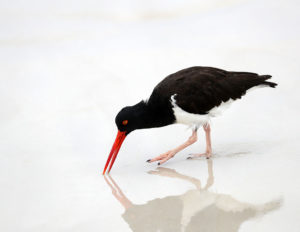While in the Galapagos, I encountered a number of bird species common in Texas or intimately related to them, including American Oystercatchers, Yellow Warblers, Yellow-crowned Night Herons, Brown Pelicans, Willets, Great Blue Herons, Semipalmated Plovers, Ruddy Turnstones and Whimbrels. Many of them are considered endemic subspecies of their Texas counterparts, and the differences are often subtle.
I flushed a Yellow-crowned Night Heron (Nyctanassa violacea) from along the rocky shoreline of Espanola and saw a number of juveniles perched on the docks in Puerto Baquerizo Moreno. Both are endemic subspecies of the same bird that strides methodically through the grass of Brazos Bend State Park.
- The first Great Blue Heron (Ardia herodias) I saw on the island was standing tall at the mouth of Tijeretas. Another was fishing inside the cove and several flew along Tortuga beach in Santa Cruz. They are permanent residents of the Galapagos and carbon copies of those on Galveston Bay.
- American Oystercatchers (Haematpus palliatus galapagensis) walk the intertidal zone, poking their robust orange beaks into the sand or pecking at shellfish washed ashore. I saw a pair plumbing the sand at Punta Carola and a lone bird scouring the shallows near Tortuga Bay. They are an endemic subspecies of those commonly seen along Galveston beaches.
- A trio of Semipalmated Plovers (Charadrius semipalmatis) hopped from rock to rock on the far end of Manglecito Beach. They are winter visitors to the Texas Coast and typically absent from the Galapagos by May, so I must have caught a few stragglers.
- The only Ruddy Turnstone Arenaria interpres) I met was foraging along the high tide line on one of the beaches near Puerto Ayora on Santa Cruz. They are another winter visitor to the Texas coast.
- From a distance, it appeared to be a Willet, but once I got a side view of its distinctive downcurving bill, it was clearly a Whimbrel (Numenius Phaeopus hudsonicus). The last group of them I saw was along the surf in Bolivar Flats.
- The Brown Pelicans (Pelecanus occidentalis urinator) on the Galalpagos were decked out in their breeding colors and busy gathering sticks for nests. A small rookery is nestled in the brush on the far end of Punta Carola and another along the coast near Manglecito. For almost a week, a flock of Pelicans chased the schools of baitfish around the Tijeretas, diving awkwardly into the water every few minutes and filling their pouches with fish, then tipping them up to swallow the catch. They created a great commotion both above and below the surface.
- Yellow Warblers (Dendroica petechia aureola) were among the few colorful birds on the islands, flitting through the trees with the more famous finches. A couple of bright yellow males hung out near the back patio of the research center while most of those in the brush nearby were the duller females. I came across another brightly colored male among the rocks by the Punta Carola lighthouse.
Texas shares many other coastal migratory birds with the Galalpagos, but I probably arrived a little to late to see them.


